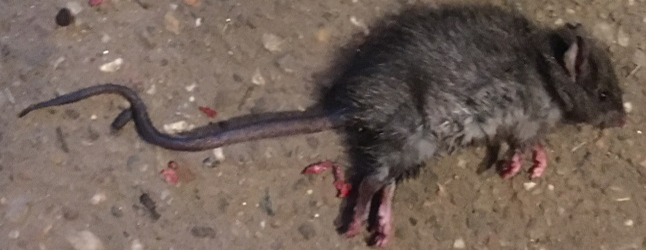
By David F. Rooney
A year or two ago complaints about rats were confined to the Big Eddy and perhaps one or two outlying areas. Fast forward to today and homeowners from Lower Town and Columbia Park to Upper Town, CPR Hill and Southside are living on edge because they fear the vermin have moved in to stay.
“It’s crazy,” said one man at Home Hardware who overheard a conversation I was having with Sheryl Hermanson about rat control. “People all over are complaining.”
And not just complaining. Most make a beeline for the hardware stores with questions on their minds.
“I think the Question of the Day is: ‘Do other people have this problem?’” Sheryl said, noting that, Home Hardware has sold more than 200 rat traps in the last five months. “That’s a ton! Last year, over five months, we sold… maybe 50 — maybe.”
Until Wednesday rat traps were impossible to find in city hardware stores. However, Home Hardware just received 50 traps and have now put them out their pest-control shelves.
Rats are not newcomers to Revelstoke. I wrote my first rat story 14 or 15 years ago about one man’s squabble with City Council over who was responsible for cleaning up a rat infestation at his home in the Big Eddy. Rat questions have even popped up in Council in the past and the answer is always the same: The City is not responsible for a resident’s issues of the ratty kind. However, it may investigate if the rats are showing up as a result other problems, such as improper storage of pet foods or garbage (basically the same things that attract bears) 9f they violate existing bylaws or regulations.
If you see a rat in your home, it is likely that a ‘full-blown’ infestation is already present
“If you see a rat in your home, it is likely that a ‘full-blown’ infestation is already present,” says information available on the Shuswap Pest Control website, one of the area’s pest control companies that also service Revelstoke. “Rats normally don’t reveal themselves unless they are cramped for space by other, more dominant rats. Due to their elusiveness, rats can be some of the most difficult rodents to remove from a home or structure. We can help.
“Once all rats have been removed then it is essential to identify all potential points of entry in order to prevent future infestations. Some of the most common entry points are vents and foundation cracks. Although, rats have been known to burrow under foundations and enter through crawlspaces or dirt floors.”
The website listed many of the signs of a rat infestation:
- Sighting of dead or live rat;
- Rat droppings;
- Finding a rat’s nest in an attic, loft or under-floorboards;
- Rat teeth markings on floorboards and walls; and
- Damaged food packaging in cupboards.
There has also been a sensible, on-again/off-again conversation on the Stoke List. “If you have rats, it’s possible that you, or your neighbors are inadvertently feeding them,” said one person who posted ratty comments on the Stoke List. “Even though it’s winter, keep your trash/recycling secure, and kindly remind your neighbors to do the same.”
Rats still act as vectors for dangerous diseases
Rats are widely regarded as vermin that act as vectors for dangerous diseases. They carried the fleas that were infected with Yerrsinia pestis, the bubonic plague bacteria. The Black Death, as it was known when it 50 million people in Europe during the 14th century. Those deaths amounted to between 25 and 60 per cent of the population. Worth noting in this age of antibiotic resistant strains of bacteria is the fact that there is no vaccine for bubonic plague and only limited protection from antibiotics.
Now a new study from UBC suggests there may be grave consequences if the rodents’ risk to human health continues to be underestimated.
The UBC researchers studied the feces of rats caught at an Abbotsford poultry farm, and discovered that not only was every specimen carrying a strain of avian E. coli, more than a quarter of the rodents carried multi-drug resistant strains of the disease.
The study’s lead author, Assistant Professor Chelsea Himsworth, had already gathered evidence of human pathogens, including MRSA and C. difficile, in the feces of rats on Vancouver’s Downtown Eastside.
“[In Abbotsford] we found that indeed rats do carry E.coli, including strains that can be harmful to chickens and be resistant to multiple antibiotics,” Himsworth told CBC News in a story it ran in January 2016.
“Previously, we thought the scope of risk associated with rats was narrow,” she said. “And now we’re saying … it’s as diverse as what is present in their environment.”
She characterizes the rodents as “pathogen sponges,” able to absorb diseases from their environment and then spread them.
That makes a growing rat population something that needs to be stemmed and, if possible, eliminated.



